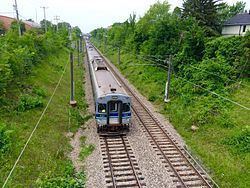Ridership 7,675,000 (2014) Operator(s) CN's Montrain division Stations 12 | Daily ridership 31,000 (2014) Opened 1918 | |
 | ||
System Agence métropolitaine de transport Terminis Deux-Montagnes, Central Station | ||
The Deux-Montagnes line is a commuter railway line in Greater Montreal, Quebec, Canada. It is owned by the Agence métropolitaine de transport (AMT), the umbrella organization that plans, integrates, and coordinates public transport services across this region.
Contents
- Railfanning the amt deux montagnes line
- Overview
- History
- Future projects
- Current status
- List of stations
- References
The line was created in 1918 as a Canadian Northern Railway (CNoR) service. Canadian National Railway (CN) ran the line starting in 1923 following the merger of CNoR into CN. CN transferred the Deux-Montagnes Line to the Société de transport de la communauté urbaine de Montréal (STCUM) on July 1, 1982. The line was refurbished from 1992 to 1995. It was transferred to the AMT on January 1, 1996.
There are 25 inbound and 24 outbound departures each weekday.
Railfanning the amt deux montagnes line
Overview
This line links Central Station in downtown Montreal with Deux-Montagnes to the northwest of the Island of Montreal.
The line offers frequent service during rush hours (10–30 minute intervals) and hourly service outside rush hours on weekdays. There is less frequent service on Saturdays and Sundays.
The trains are owned and managed by the Agence métropolitaine de transport and are operated by Canadian National's Montrain division.
Deux-Montagnes, Roxboro-Pierrefonds, and Central Station are wheelchair-accessible.
Today, more than 31,000 people ride this train daily, having almost as many passengers as Montreal’s four other commuter railway lines combined.
On April 22, 2016, it was announced that the Deux-Montagnes line would be converted from commuter rail to automated electric rapid transit in 2020, as part of the Réseau électrique métropolitain network.
History
The Deux-Montagnes line was built by the Canadian Northern Railway. While other railways including Canadian Pacific and Grand Trunk Railway already had prime downtown locations for their terminal stations, Canadian Northern did not, having only a station out of the way on Moreau Street in Hochelaga.
In 1910, it was decided that the best way for Canadian Northern to get downtown was to drill their way downtown — through Mont Royal. The construction started at both ends and met half way through with only an inch difference. In 1918 the electrified (2400 V DC catenary), double-track 3.2 mi (5.15 km) tunnel was dubbed Montreal’s first subway. Because the tunnel is on a steep grade and inadequately ventilated it was decided from the very beginning that the locomotives would be electric. The ventilation shaft is located SW of the intersection of Édouard-Montpetit Boulevard and Vincent-d'Indy Avenue very close to the Édouard-Montpetit Metro Station.
The structure gauge of the Mount Royal Tunnel limits the height of bilevel cars to 14 ft 6 in or 4.42 m.
In order to finance the project, Canadian Northern built a ‘model city’ north of the tunnel, modeled after Washington, D.C. The Town of Mount-Royal has grown to be an upper-income neighborhood today. Construction began in 1912 and finished in 1918. The first train was pulled by electric locomotive #601 (retired as #6711), which left Tunnel Terminal at 8:30 a.m. on October 21, 1918. The Canadian Northern Railway went bankrupt and was absorbed into what is now Canadian National. Tunnel Terminal was replaced by Central Station in 1943. CN added electric multiple units from Canadian Car and Foundry in 1952.
In the 1960s, the first plans were announced to renovate the line, whose equipment was 40 years old at the time. First, it was to become metro line 3, but plans were shelved because of the importance to build line 4 for service to Expo 67. With the equipment ageing, and ridership declining, CN wanted to close the line in the 1970s, but their proposals were rejected. The Quebec Ministry of Transport considered using the line for a high-speed connection to Mirabel Airport (Transport rapide régional aéroportuaire Montréal Mirabel, 1974) or as the first line of a BART-style regional metro system (Réseau express de Montréal, 1977; Métro régional, 1979). None of these projects progressed beyond the planning stage.
In 1982, the fares for the trains were integrated with the fares for the Metro and buses. The fare was two bus tickets. This was later reduced to one from Central Station to Val-Royal (now Bois-Franc).
In 1992, the government of Quebec announced a modernisation plan for the line which would include 58 state-of-the-art 25 kV AC MR-90 electric multiple-unit trains built by Bombardier Transportation, new tracks, and centralised traffic control. Service was shut down completely in the summers of 1993, 1994 and 1995 to allow for major work to be done. The last of the old rolling stock left Central Station at 6:30 p.m. on June 2, 1995 – 76 years, 8 months, 11 days, and ten hours after it first went into service. The same locomotive, #6711 (with #6710 (pictured)), hauled the last train through the tunnel.
Future projects
To ease overcrowding and attract new users on the Deux-Montagnes Line, the AMT plans to carry out several projects:
Under the Réseau électrique métropolitain proposal, the Deux-Montagnes line would be converted to rapid transit operation and be extended past Downtown and over the St-Lawrence to Brossard; two southwest branches would also be added, to Trudeau Airport and to Sainte-Anne-de-Bellevue.
Current status
List of stations
The following stations are on the Deux-Montagnes line:
As of January 9, 2012 many bus line number have changed.
The Deux-Montagnes line uses the former CN Deux-Montagnes Subdivision between mile 0.8 (Central Station) and 19.4 (Deux-Montagnes). The AMT now owns it.
